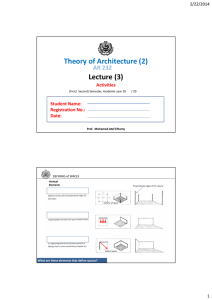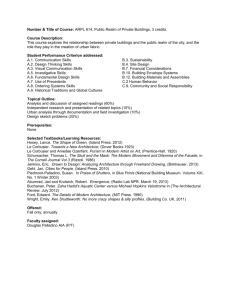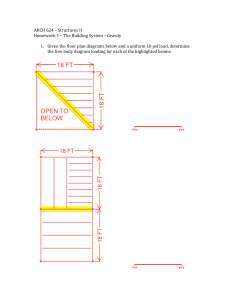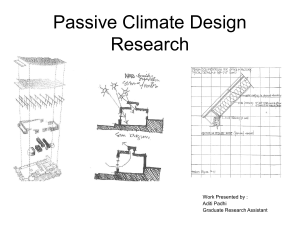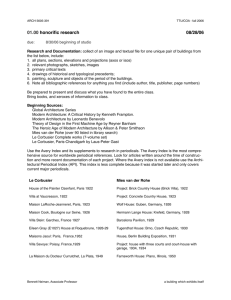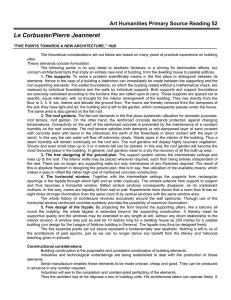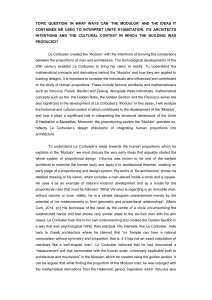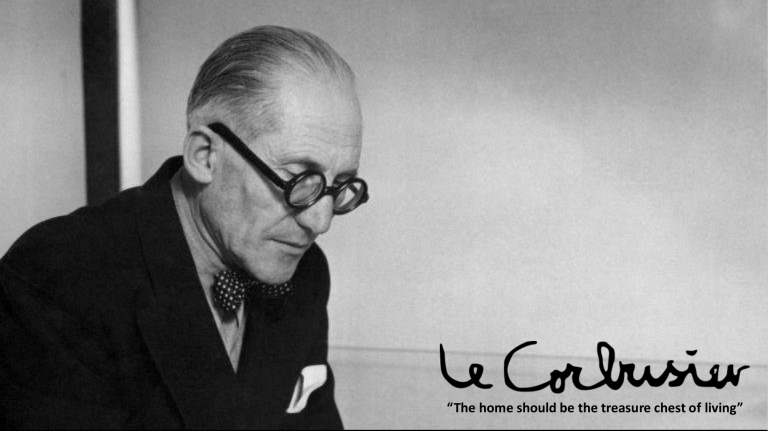
“The home should be the treasure chest of living” INTRODUCTION REAL NAME : Charles-Édouard Jeanneret-Gris BORN : October 6, 1887 - La Chaux-de-Fonds, Switzerland DIED : August 27, 1965 - Roquebrune-Cap-Martin, France NATIONALITY : Swiss, French [1930] OCCUPATION : Architect, Designer, Painter, Urban Planner, Writer, Pioneer ACCOMPLISHMENT : Honorary degree by University of Cambridge - 1959 AIA gold medal - 1961 Frank P. Brown Medal – 1961 Founding member of Congrès international d'architecture modern 17 of his buildings are inscribed in UNESCO World Heritage Sites FAMILY : Georges Edouard Jeanneret (Father) Marie Charlotte Amélie Jeanneret-Perret (Mother) Yvonne Gallis (Spouse) EARLY LIFE & CAREER • • • • • • • • • • • • Attended a kindergarten that used Fröbelian methods Attracted to the visual arts and studied at the La-Chaux-de-Fonds Art School under Charles L'Eplattenier Architect René Chapallaz – Architecture teacher in school – large influence on Charles’ early works In his early years, he travelled around Europe Travelled to Paris – worked in the office of Auguste Perret – 1908 Berlin – worked in the office of Peter Behrens – met Ludwig Mies van der Rohe and Walter Gropius – 1910 ~ 1911 Visit to the Charterhouse of the Valley of Ema - influenced his architectural philosophy profoundly for the rest of his life Journeyed to the Balkans and visited Serbia, Bulgaria, Turkey, and Greece, filling nearly 80 sketchbooks with renderings of what he saw – 1911 During World War I, Charles taught at his old school in La-Chaux-de-Fonds These four years in Switzerland, he worked on theoretical architectural studies using modern techniques Charles met the Cubist painter Amédée Ozenfant, in whom he recognised a kindred spirit – 1918 Charles-Edouard Jeanneret adopted Pseudonym - Le Corbusier - 1920 IDEAS • FIVE POINTS OF ARCHITECTURE 1. 2. 3. Pilotis – Replacement of supporting walls by a grid of reinforced concrete columns that bears the structural load is the basis of the new aesthetic The free designing of the ground plan—the absence of supporting walls—means the house is unrestrained in its internal use The free design of the façade—separating the exterior of the building from its structural function—sets the façade free from structural constraints. The horizontal window, which cuts the façade along its entire length, lights rooms equally. Roof gardens on a flat roof can serve a domestic purpose while providing essential protection to the concrete roof. 4. 5. • Most succinctly summed up the five points of architecture – VILLA SAVOYE IDEAS • MODULOR • The graphic representation of the Modulor, a stylised human figure with one arm raised, stands next to two vertical measurements • Attempts to discover mathematical proportions in the human body and then to use that knowledge to improve both the appearance and function of architecture • The system is based on human measurements, the double unit, the Fibonacci numbers, and the golden ratio • Le Corbusier described it as a “range of harmonious measurements to suit the human scale, universally applicable to architecture and to mechanical things” • Intrigued by ancient civilisations who used measuring systems linked to the human body: elbow (cubit), finger (digit), thumb (inch) etc. • A red series based on the figure's navel height (1.08 m in the original version, 1.13 m in the revised version) then segmented according to Phi • A blue series based on the figure's entire height, double the navel height (2.16 m in the original version, 2.26 m in the revised), segmented similarly • A spiral, graphically developed between the red and blue segments, seems to mimic the volume of the human figure IDEAS • OPEN HAND • The Open Hand (La Main Ouverte) is a recurring motif in Le Corbusier's architecture - a sign for him of "peace and reconciliation. It is open to give and open to receive” • The largest of the many Open Hand sculptures that Le Corbusier created is a 26 meter high version in Chandigarh, India – known as OPEN HAND MONUMENT • FURNITURE • “Chairs are architecture, sofas are bourgeois” • Le Corbusier and Perriand began to put the expectations for furniture Le Corbusier outlined in his 1925 book L'Art Décoratif d'aujourd'hui into practice • three different furniture types: type-needs, typefurniture, and human-limb objects • Le Corbusier began experimenting with furniture design in 1928 after inviting the architect, Charlotte Perriand IDEAS FAMOUS WORKS 1. 5. 1. Unité d'habitation 2. Maisons Jaoul 3. 2. 6. 3. Mill Owner’s Association 4. Palace of Justice 4. 7. 5. Sanskar Kendra 6. Villa Shodhan 8. 7. Villa Schwob 8. Maison Guiette/Les Peupliers DOM – INO HOUSE • A prototype as the physical platform for the mass production of housing • Design idea to manufacture in series, that combines the order he discovered in classical architecture • The units could be aligned in a series like dominoes, to make row house of different patterns • This design became the foundation for most of his architecture for the next ten years 1914 Concrete slabs Giving freedom to design the interior configuration Stairway providing access to each level on one side of the floor plan Thin, reinforced concrete columns - Pilotis Free facade CHANDIGARH CITY PLANNING Located at the picturesque junction of foothills of the Himalayas Mountain range and the Ganges plains Total area 114 sqkm & population of 1,054,600 inhabitants Sector of size 800 x 1200 meters Each SECTOR is a self-sufficient unit having shops, school, health centres and places of recreations and worship 800 Typical sector plan Sector Main axis Green Areas Road Network 1200 • • • • 1950-1970 CHANDIGARH CITY PLANNING • Analogous to human body • Head (the Capitol Complex, Sector 1), • Heart (the City Centre Sector17), • Lungs (the leisure valley, innumerable open spaces and sector greens), • Intellect (the cultural and educational institutions), • Circulatory system (the network of roads, the 7Vs) • Viscera (the Industrial Area). 1950-1970 CHANDIGARH CITY PLANNING 1950-1970 • Basic Building Typology - extremely Rectilinear with similar proportions 1. City Level Public Green Space with Artificial Water Body 2. Free- Flowing Green Space, connecting the entire site 3. Semi-Private Green Areas for nearest pockets 4. Private Green Areas for Residential Units • Sector 17- main public congregation area • Houses all major shopping complexes, sports facilities and congregation spaces • smaller individual Residential Units are arranged around central common Green Spaces CAPITOL COMPLEX 1. 1950-1970 6. 3. 7. 2. 1. Palace of Justice 2. Secretariat Building 4. 3. Palace of Assembly 4. Geometric Hill 5. 5. Open Hand Monument 6. Martyr’s Memorial 7. Tower of Shadows CAPITOL COMPLEX • All the masterpieces stand together, representing the democratic India • Also contains Piazzas, Water Pools and Gardens • Separated by large piazzas • The open hand stands in centre-emblem of Chandigarh • The pools are being constructed in front of the High Court and the Assembly • A concrete structure that represents the monumental character authority of the government • Earlier it was designed to be in the centre of the city as a dominant element, but later on it was placed from the city as the head – “City must never be seen” 1950-1970 Palace of Assembly Secretariat Building Tower of Shadows & Geometry Hills Piazza CAPITOL COMPLEX 1950-1970 1. Palace of Justice (1951-1957): 1. The structure has a double roof projecting over the office block - like a parasol or an inverted umbrella 2. Three vertical piers rising 60 feet from the floor and painted in bright colors – entrance 3. Gigantic egg-crate screen covers the building façade 4. Woollen tapestries on the rear walls of the courtrooms 3. 1. 2. 4. CAPITOL COMPLEX 1950-1970 2. Palace of Assembly (1955): 1. A large box with the entrance portico on one side 2. Concrete piers on the other, and a repetitive pattern on the façade 3. Sculptural forms on the roof, a dramatic ‘funnel’ top light over the Assembly, and a tilted pyramid over the Senate chambers completed the composition 4. The Assembly chamber, in the form of a hyperbolic shell, is surrounded by ceremonial space 3. 1. 4. 2. CAPITOL COMPLEX 1950-1970 3. Secretariat (1953-1959): 1. Shaped in the form of an eight-storied concrete slab 2. Sculptured two-storey porticos in the centre 3. The cafeteria - giving a spectacular view of the city 4. The façade - kind of wall of images due to the wall of glass that covers compartmentalized and composed as a page 5. Roof space - garden terrace - closer to nature as far these huge concrete blocks 6. Exposed concrete ramps - perforated with small square windows dominating the front and rear views 1. 4. 6. 2. CAPITOL COMPLEX 3. 1950-1970 5. VILLA SAVOYE • LOCATION • MATERIAL : Poissy, France : Reinforced Concrete • Planned the entire composition as a sequence of spatial effects • Arriving by automobile, the visitor drives underneath the house, circling around to the main entrance • Stairs and Ramp for circulation - Sheltered by brightly colored wind screens • Celebrates Le Corbusier's belief that ideal, universal forms, although rooted in the classical tradition, were appropriate to architecture for the machine age • Houses to be "machines for living in." 1929-1931 VILLA SAVOYE • Modulor design : The result of Le Corbusier's researches into mathematics, architecture (the golden section), and human proportion • No historical ornament - Abstract sculptural design • Pure color : White on the outside - newness, purity, simplicity, and health • Spiral staircases and ramps : Dynamic , non-traditional transitions between floors 1929-1931 VILLA SAVOYE 1929-1931 • Five points of architecture Long horizontal windows Freely-designed facades Support of ground-level pilotis Functional roof Free floor plan CHAPEL OF RONCHAMP • • • • 1953-1955 LOCATION : Ronchamp, France MATERIAL : Reinforced Concrete, Stone Singular in Corbusier's work, in that it departs from his principles of standardization and the machine aesthetic Giving a site-specific response • Upturned roof • Appears to float above the walls • The different-sized windows are scattered in an irregular pattern across the wall • A wall starts out as a point on the east end, and expands to up to 10 feet thick its west side • The openings slant towards their centres at varying degrees, thus letting in light at different angles • Derived from a proportional system based on the Golden Section QUOTES • The home should be the treasure chest of living. • A house is a machine for living in. • I prefer drawing to talking. Drawing is faster, and leaves less room for lies. • Architecture is the learned game, correct and magnificent, of forms assembled in the light. • Space and light and order. Those are the things that men need just as much as they need bread or a place to sleep. • A hundred times have I thought New York is a catastrophe, and fifty times : It is a beautiful catastrophe. • To create architecture is to put in order. Put what in order? Function and objects. • The "styles" are a lie. • You employ stone, wood and concrete, and with these materials you build houses and palaces. That is construction. Ingenuity is at work. But suddenly you touch my heart, you do me good, I am happy and I say: "This is beautiful." That is Architecture. Art enters in. • It is a question of building which is at the root of the social unrest of today: architecture or revolution. • Modern life demands, and is waiting for, a new kind of plan, both for the house and the city. • The age of personal statues is gone.
